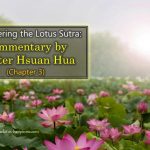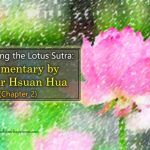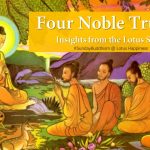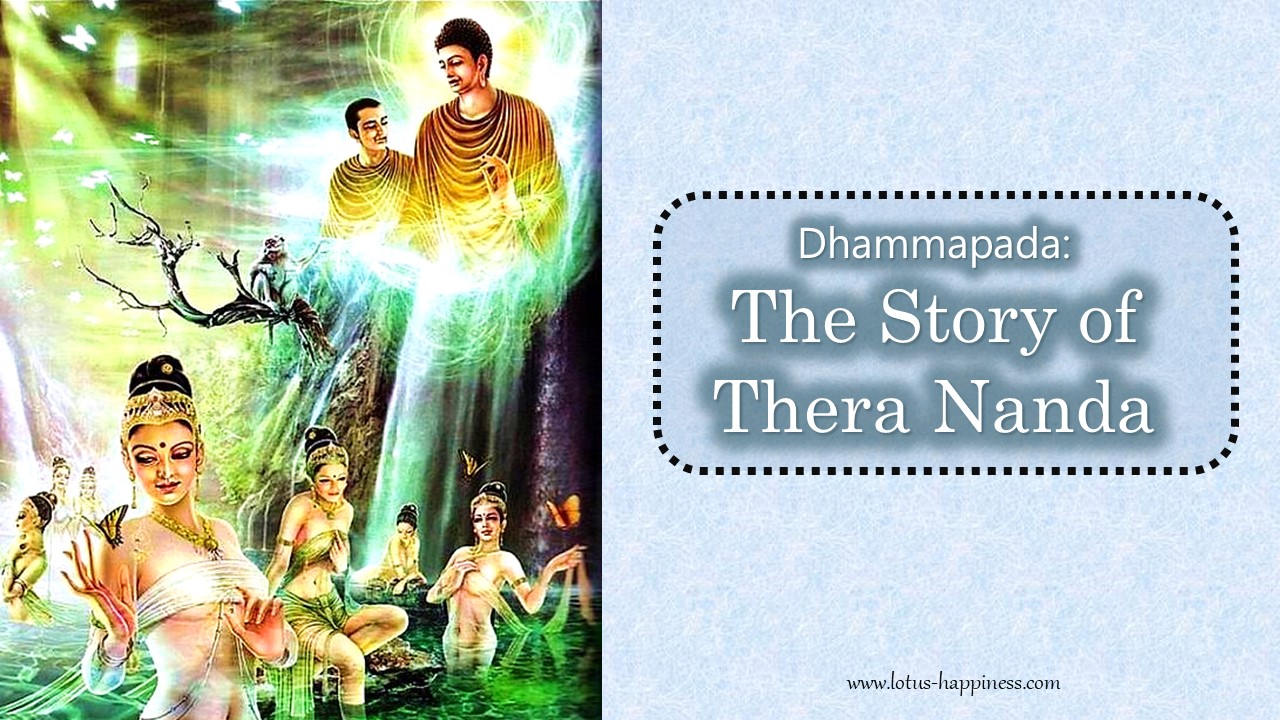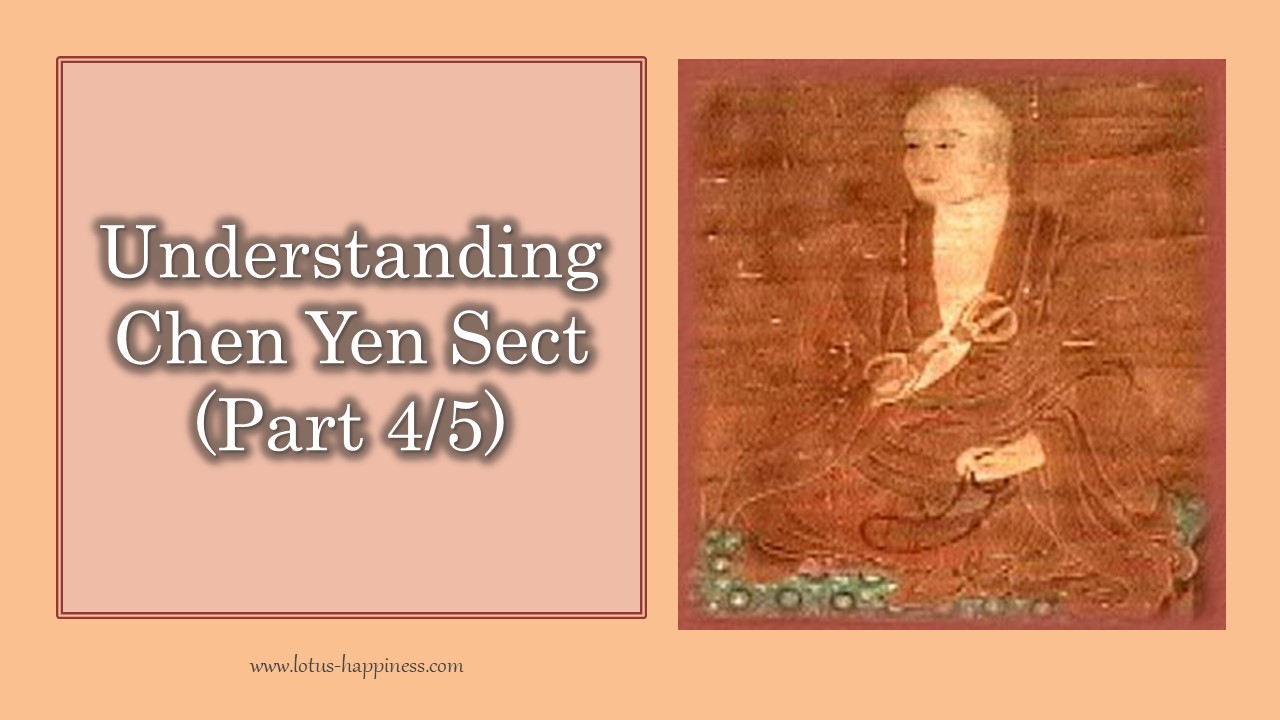Deciphering the Lotus Sutra
Commentary by Master Hsuan Hua (Chapter 1 – HS 1.1)
Quotes in the Lotus Sutra:
Thus have I Heard
Master Hsuan Hua’s Commentary:
The Wonderful Dharma Lotus Flower Sutra contains twenty-eight chapters. The first chapter, “Introduction,” narrates the causes and conditions leading up to the speaking of the Sutra. Although the first passage of text of all Sutras is an introduction, this is the only Sutra that devotes an entire chapter to an introduction.
Thus have I heard. (Every Dharma Assembly must fulfill six requirements: faith, hearing, time, host, place, and audience.) “Thus” fills the requirement of faith. “I have heard” fills the requirement of hearing. (On Sunday during the lecture on the Vajra Sutra, the reasons behind these four words were already explained.) Dharma which is “Thus” can be believed; dharma which is not “Thus” cannot be believed.
Who is the “I” referred to here? There is the false self of the common person, and there is the divine self of non-Buddhist religions.
Here the “I” refers to the “false self,” not the true self.
You may ask, “Why does the text say, “I” heard? Basically isn’t it the ear which hears? Why doesn’t it say the ear heard?”
The ear is just one part of the body. The “I” refers to the entire body. Therefore Ananda said, “I have heard”.
Ananda spoke the words “Thus have I heard” for four reasons:
- To resolve the assembly’s doubts.
2. To honor the Buddha’s instructions.
3. To put an end to disputes.
4. To distinguish Buddhist Sutras from the writings of other religions.
What doubts did the assembly hold? When Ananda compiled the Sutras and took the Dharma seat, he manifested the characteristics of the Buddha and thus caused the assembly suddenly to give rise to three doubts:
First of all, the Bodhisattvas, Arhats, and Bhikshus thought perhaps Shakyamuni Buddha hadn’t entered Nirvana after all, but had returned again to lecture on the Sutras.
Others thought, “This must be the Buddha from another place who has come to teach us.”
Still others thought, “Ananda has become a Buddha!” Otherwise, how could he manifest the thirty-two marks and eighty minor characteristics of a Buddha? How could he, surrounded by this dazzling purple-golden light, appear so splendid?”
But when Ananda took the Dharma seat and said, “Thus have I heard”, the three doubts were all resolved. The Bodhisattvas, Arhats, and Bhikshus then knew Ananda was saying, “This is the Dharma. It is thus. Thus it was that I personally heard this Dharma from the Buddha. It is not my own invention.”
The second reason the words “Thus have I heard” were used was in order to honor the Buddha’s instructions. When the Buddha was about to enter Nirvana, he told Ananda, “All the Sutras should begin with the words ‘Thus have I heard.’” And so when Ananda compiled the Sutras, he followed the Buddha’s instructions and used these four words at their beginning.
The third reason was to put an end to disputes. Ananda was one of the youngest of the Buddha’s disciples. If he hadn’t made it clear that the Sutras he was speaking were the Buddha’s and not his own, there would certainly have been objections. “You say you can speak Sutras? Well, so can we!” people would have said. But when Ananda said that the Sutras were not his own but were the Buddha’s, all the assembly, including his elders, his peers, and his juniors, had nothing to say. They were the Buddha’s Sutras. This silenced their objections and ended all disputes.
The fourth reason was to distinguish the Buddha’s Sutras from the writings of other religions. The texts of other religions begin their works with the words “A” or “O” meaning “non-existence” or “existence”, respectively. They say that all the ten thousand dharmas either exist or do not exist. The phrase “Thus have I heard” at the beginning of the Buddha’s Sutras sets them apart from the writings of other religions, which have a head but no tail, or a tail no head, because they advocate either existence or non-existence.
Ananda asked the Buddha about four matters before the Buddha entered Nirvana. The first concerned the compilation of the Sutras, and the Buddha replied that all Sutras should begin with the words, “Thus have I heard.” The second question was where the Buddha’s disciples should dwell, and the Buddha told them to dwell in the Four Applications of Mindfulness: mindfulness with regard to the body, feelings, thoughts, and dharmas.
The Four Applications of Mindfulness:-
- Contemplate the body as impure.
2. Contemplate feelings as suffering.
3. Contemplate thoughts as impermanent.
4. Contemplate dharmas as without self.
The first Application of Mindfulness is to contemplate the body as impure. Our bodies constantly perspire, no matter how often we wash them. If you don’t wash, they soon begin to stink. Impurities always ooze from the nine openings on the body. Tears and matter flow from the eyes. Wax accumulates in the ears. Mucus comes from the nose. Phlegm and saliva come from the mouth. These are all unclean. No matter how much you wash on the outside, the inside is still filthy. We’ve discussed seven orifices so far. Add excrement and urine from the eliminatory orifices and that makes nine. Therefore you should contemplate the body as impure.
Living beings burdened with heavy greed should cultivate the contemplation of impurity and view the uncleanness of the body. Greed here refers to sexual desire. Those afflicted with sexual desire should apply this contemplation to counteract lust. No matter how beautiful the woman or how attractive the man they are still basically unclean. Since they are impure, how can you cling to them? Understanding their basic impurity, you won’t keep longing for them, and your sexual desire will diminish.
The second is to contemplate feelings as suffering. Everything you experience, be it pleasant or unpleasant, moves your mind. When your mind moves, that is suffering. There are many kinds of suffering. There are the Three Sufferings, the Eight Sufferings, and all the limitless sufferings. The Three Sufferings are:
- The suffering within suffering.
2. The suffering of decay.
3. The suffering of process.
The Eight Sufferings are:
- The suffering of birth,
2. old age,
3. sickness, and
4. death.
5. The suffering of being separated from what one loves.
6. The suffering of being around what one hates.
7. The suffering of not getting what one wants.
8. The suffering of the raging blaze of the five skandhas.
The Three Sufferings are present within the Three Realms: the Desire Realm, the Form Realm, and the Formless Realm. No matter what you feel, it is bound up with suffering. If you can understand this, you won’t crave pleasure and you’ll be able to avoid suffering.
The third Application of Mindfulness is to contemplate thoughts as impermanent. In our minds, when one thought is produced, the former thought is extinguished. When yet another thought arises, the preceding one perishes. Thoughts succeed one another like the waves on the sea. Thought after thought arises without cease, but they are all impermanent. Every thought is vain and unreal. Therefore you should contemplate thoughts as impermanent.
The fourth Application of Mindfulness is to contemplate dharmas as without self. What are dharmas? Generally they are divided into five categories. They are explained in detail in the Shastra to the Door of Understanding the Hundred Dharmas, by Bodhisattva Vasubandhu.
There are eleven form dharmas.
There are eight mind dharmas.
There are fifty-one dharmas belonging to the mind.
There are twenty-four dharmas non-interactive with the mind.
There are six unconditioned dharmas.
Altogether there are a hundred dharmas. Although there are so many dharmas, among them all there is no self. Therefore, you should not be attached to dharmas. The Vajra Sutra says, “Even dharmas should be cast aside, how much the more so that which is non-dharma?” When you have cultivated to the extreme limit where both people and dharmas are both empty, you must give up attachment to dharmas. If you become attached to the existence of dharmas, you contract the Dharma Attachment. There are two kinds of attachments, the Self Attachment and the Dharma Attachment. Before people have understood the Buddhadharma, they are attached to the self. Everything revolves around themselves. With attachment they become obstructed, deluded, and filled with dream thoughts.
Once you understand the Buddhadharma, you may give rise to Dharma Attachments. So the Buddha spoke the Four Applications of Mindfulness and taught us to contemplate dharmas as devoid of self. Contemplate all dharmas as having no self. Since there is no self, how could there be dharmas? Therefore you must contemplate dharmas as without a self.
Contemplate the body as impure; feelings, thoughts, and dharmas are also impure. Contemplate feelings as suffering; the body, thoughts, and dharmas are also suffering. Contemplate thoughts as impermanent and also the body, feelings, and dharmas. Contemplate dharmas as without self, and also the body, feelings, and thoughts. The Four Applications of Mindfulness are thus mutually related. The Buddha told his disciples that after his Nirvana they should always dwell in these Four Applications and never leave them.
In answer to the third question that Ananda asked [regarding whom the disciples should take as their teacher after the Buddha entered Nirvana], the Buddha said, “Take the Pratimoksha, the precepts, as your teacher.” All Bhikshus and Bhikshunis must cultivate in accord with the precepts. If you do not rely upon the precepts in cultivation, the Dharma will become extinct. If the precepts are relied upon, the Buddhadharma will remain in the world.
For every person who cultivates according to the precepts, Buddhism has just that much more light. If ten people cultivate according to the precepts, then Buddhism will give off ten parts of light. If a hundred, a thousand, ten thousand people cultivate according to the precepts and do not violate them, then boundless, limitless light will destroy all the darkness in the world. Therefore in cultivation, holding the precepts is essential.
As to Ananda’s fourth question, “How should we treat evil-natured Bhikshus?” the Buddha said, “Simply be silent and ignore them. There is no way to reason with them. All you can do is refuse to talk to them. They will become ashamed of themselves and may even come around to following the rules. The best method is not to argue with them.”
The word ‘thus’ expresses the credibility of the Dharma which is about to be heard. The Dharma which you may believe is ‘thus’. Dharma which you may not believe is not ‘thus’.
It accords with conditions, yet does not change.
It does not change and yet accords with conditions.
It is thus, thus unmoving;
The Dharma, clear and constantly bright–
Thus it is.
‘Thus’ also means it is ‘sealed with approval’. If you do things correctly, if you do things in accord with the Buddha’s heart, then it is ‘thus’. If you are at variance with the Buddha’s heart, then it is not ‘thus’.
“I have heard” is Ananda saying, “The Dharma which is thus is that which I personally heard the Buddha speak. It is not my own invention or my own creation. I heard it from the Buddha.”
Ananda was quite a bit younger than the Buddha. In fact, the Buddha left home when he was nineteen and accomplished the Way when he was thirty. Ananda was born on the day the Buddha accomplished the Way and, at twenty, he left home and served the Buddha. Therefore he did not hear the Dharma taught by the Buddha during the first twenty years of teaching. How then, was Ananda able to compile the Sutras if he hadn’t even heard those first twenty years of the Buddha’s teaching?
That’s a good question. Ananda was the Buddha’s cousin; he left home when he was twenty and made the vow to remember and record all the Buddha’s words. But since he hadn’t heard the first twenty years of the Buddha’s teaching, he requested the Buddha to repeat it all for him. So the Buddha, in secret, respoke all the Sutras to Ananda who, by means of his excellent memory, remembered them all perfectly. Thus, from beginning to end, all the Dharma the Buddha spoke went past his ears directly into his heart and was never forgotten. Therefore, it is said,
“The great sea of the Buddhadharma
flowed right into Ananda’s heart.”
Ananda was actually a great Bodhisattva who manifested provisionally as an Arhat. All the Sutras of the past Buddhas were compiled by Ananda. That is why, after his enlightenment, he was able to remember all the Dharma spoken by the Buddhas of the past. The Dharma spoken by all the Buddhas is essentially the same. For that reason, in the Dharma assembly of Shakyamuni Buddha, Ananda was able to entirely recall the Sutras he had been taught in the past, even though he did not hear them in this life.
Source: Hsuan Hua


